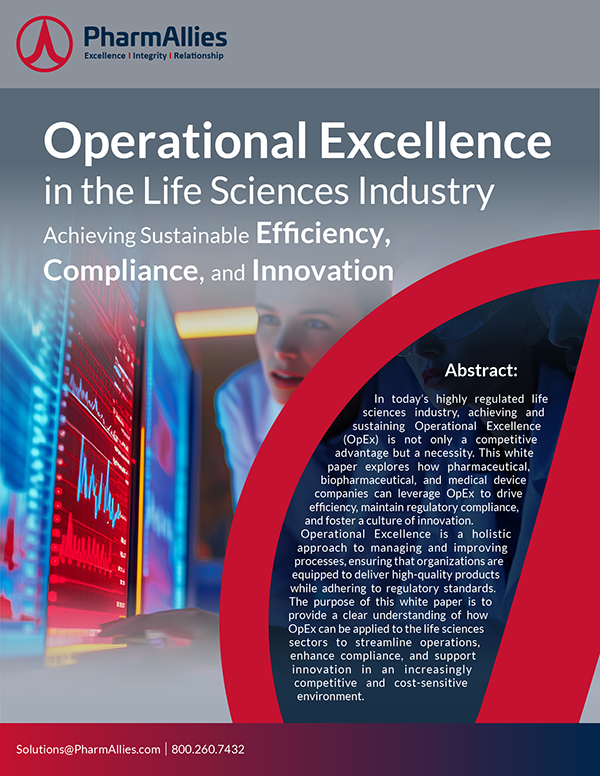Overcoming Regulatory Challenges in Operational Excellence
Introduction
In the life sciences industry, regulatory compliance isn’t just a requirement, it’s the foundation upon which everything else is built. Every stage of developing, manufacturing, and distributing pharmaceuticals, biopharmaceuticals, and medical devices is governed by strict standards designed to protect public health and safety. Regulatory agencies such as the FDA, EMA, and ISO set the bar high, leaving no room for error. However, meeting these requirements often feels like a significant obstacle to operational efficiency, introducing complexities that can slow down your progress and strain resources.
For you, balancing the dual demands of compliance and operational efficiency is not only critical but also achievable. By addressing regulatory challenges head-on and integrating compliance seamlessly into your processes, you can create a streamlined, effective operation without compromising quality or safety. This article explores the most common regulatory hurdles in life sciences and provides actionable strategies to overcome them, enabling you to stay compliant while achieving Operational Excellence (OpEx).
Understanding Regulatory Challenges in Life Sciences
1. Complex Compliance Requirements
In the life sciences industry, we must comply with multiple overlapping regulatory frameworks, including Good Manufacturing Practices (GMP), Good Clinical Practices (GCP), Good Laboratory Practices (GLP), and guidelines from the FDA and EMA. Each standard has specific requirements that govern every step, from raw materials sourcing to final product testing. Staying compliant while improving processes can be a delicate balancing act. This is one of the many reasons why some in the industry don’t look forward to implementing Operational Excellence projects.
2. Evolving Regulatory Standards
Regulatory requirements are constantly evolving to keep up with technological advances, emerging risks, and new market dynamics. As a result, you often need to adjust your processes, documentation, and quality assurance practices to stay compliant. Adjusting your workflows and documentation without disrupting operations is no small task.
3. Data Integrity and Security
With the rise of digital transformation in life sciences, regulatory agencies are increasingly focused on data integrity, cybersecurity, and transparency. You must ensure that all electronic records and data are accurate, traceable, and secure, especially when they rely on automated systems or cloud-based platforms. This adds complexity to OpEx initiatives as you must factor in additional controls and audit trails.
4. Risk Management and Quality Assurance
You must consistently manage risks that could impact product quality, safety, and regulatory compliance. Regulatory frameworks, including ICH Q9 Quality Risk Management (QRM), emphasize proactive risk management. However, implementing risk-based approaches can be challenging without a structured framework like OpEx to support it.
Strategies to Overcome Regulatory Challenges in Operational Excellence
1. Integrating Compliance into OpEx Initiatives
Successful OpEx initiatives are built on a foundation of compliance. Rather than treating compliance as a separate function, it should be embedded within every operational process. This proactive approach helps you maintain quality while meeting regulatory standards more effectively. In the end, you would have a seamless integration of compliance into daily operations that minimizes regulatory risks while fostering continuous improvement. In my experience, the best way to apply this is by.
-
Adopt Quality Risk Management (QRM): Use QRM to identify and prioritize high-risk areas that require closer monitoring and control. This ensures that improvements align with compliance goals.
-
Conduct Regular Compliance Audits: Incorporate routine audits into your OpEx processes to ensure compliance with evolving regulatory standards.
-
Align Goals: Set OpEx goals that explicitly account for compliance requirements. For example, if a process needs to be streamlined, ensure that it also meets necessary GMP standards.
2. Leverage Technology for Enhanced Compliance and Traceability
Technology, such as AI, IoT, and cloud platforms, has become essential for maintaining compliance in today’s digital world. These tools help you track and monitor processes in real-time, enhancing visibility and traceability. However, it’s essential to ensure that these technologies are compliant with regulations like FDA’s 21 CFR Part 11. By leveraging technology for enhanced compliance and traceability, you increase compliance visibility, reduce the risk of data integrity issues, and enhance readiness for regulatory audits. I have leveraged technology for enhanced compliance and traceability in multiple projects.
-
Implementing Data Integrity Protocols: Use audit trails, secure electronic signatures, and data encryption to ensure data integrity. Make sure all technology systems are validated according to CSA (Computer Software Assurance) principles.
-
Using IoT for Real-Time Monitoring: Equip manufacturing and lab environments with IoT devices to track environmental conditions, equipment performance, and production data. Real-time monitoring can flag potential compliance issues before they escalate.
-
Centralize Compliance Data: Store compliance data in a secure, cloud-based platform to ensure easy access, transparency, and traceability during audits.
3. Implementing Risk-Based Quality Management
Regulatory bodies like the FDA and EMA encourage risk-based quality management, where you focus resources on high-impact areas. By aligning OpEx initiatives with a risk-based approach, you can prioritize improvements that reduce compliance risks while enhancing quality. The outcomes are a structured, risk-based approach to quality that aligns with regulatory expectations and improves overall operational control. You can implement this by.
-
Identify Critical Quality Attributes (CQAs) and Critical Process Parameters (CPPs): These metrics are essential to product quality and compliance, making them a focal point for your risk-based OpEx.
-
Develop Risk Assessment Tools: Tools like Failure Mode and Effects Analysis (FMEA) can help you identify and prioritize risks across processes, allowing you to apply OpEx solutions where they’re most needed.
-
Set Control Plans: Use Six Sigma’s DMAIC (Define, Measure, Analyze, Improve, Control) framework to establish control plans for high-risk areas, ensuring consistent quality and compliance.
4. Ensuring Training and Workforce Readiness for Compliance
Regulatory compliance isn’t just about having the right processes in place; it’s about ensuring that the entire workforce is prepared and informed. Train your people in compliance and OpEx principles ensures that everyone understands their role in maintaining quality and regulatory standards. Wouldn’t you love to have a skilled, knowledgeable workforce that actively contributes to compliance efforts, reducing risk and improving your regulatory standing? In my experience, the best way to implement this is by.
-
Regular Compliance Training: Develop training programs that cover essential regulatory standards (GMP, GCP, GLP) and specific OpEx tools and methodologies relevant to compliance.
-
Certifications and Continuous Learning: Encourage your people to pursue certifications like Lean Six Sigma, GMP, and compliance-specific training. Continuous learning helps them stay updated on best practices and regulatory changes.
-
Empower Quality Teams: Give quality assurance teams the authority to oversee compliance and OpEx initiatives, ensuring that improvements don’t compromise regulatory standards.
Benefits of Integrating OpEx with Regulatory Compliance
If you can integrate OpEx with compliance, you can bring measurable improvements.
-
Reduced Compliance Costs: By embedding compliance into daily operations, you can lower the costs of regulatory adherence and reduce the likelihood of fines or recalls.
-
Faster Time-to-Market: OpEx helps you streamline compliance processes, enabling faster, smoother transitions from development to production and distribution.
-
Improved Audit Readiness: With OpEx tools, your compliance and quality teams are better prepared for regulatory inspections, reducing stress and ensuring a smoother audit process.
-
Enhanced Quality and Safety: Risk-based quality management strengthens product consistency and safety, leading to better patient outcomes and improved brand reputation.
Conclusion
Regulatory compliance doesn’t have to slow you down, it can be a catalyst for creating stronger, more efficient processes that drive lasting success. When you integrate Operational Excellence (OpEx) principles with compliance requirements, you not only meet industry standards but also position yourself to lead in an increasingly competitive market. By proactively addressing compliance challenges and embedding them into your workflows, you ensure quality, safety, and operational efficiency go hand in hand.
Through risk-based approaches, digital transformation, and a well-trained workforce, you can transform compliance from a perceived obstacle into an organizational strength. These strategies not only help you navigate regulatory complexities but also foster a culture of continuous improvement and innovation. The result? Streamlined operations, faster time-to-market, reduced costs, and better outcomes for patients.
Now is the time to embrace the synergy between compliance and Operational Excellence. By implementing these strategies, you’ll create a resilient, forward-thinking operation that meets today’s regulatory challenges while staying agile for the future. Together, quality, safety, and efficiency become the cornerstones of your success in the life sciences industry.
Want to learn more about Operational Excellence (OpEx) in the Life Sciences industry?
Follow us on LinkedIn and Download PharmAllies’ White Paper on Operational Excellence (OpEx) in the Life Sciences Industry.
Download the White Paper HERE

Discover how Operational Excellence drives efficiency, compliance, and innovation in life sciences with PharmAllies’ latest white paper.


